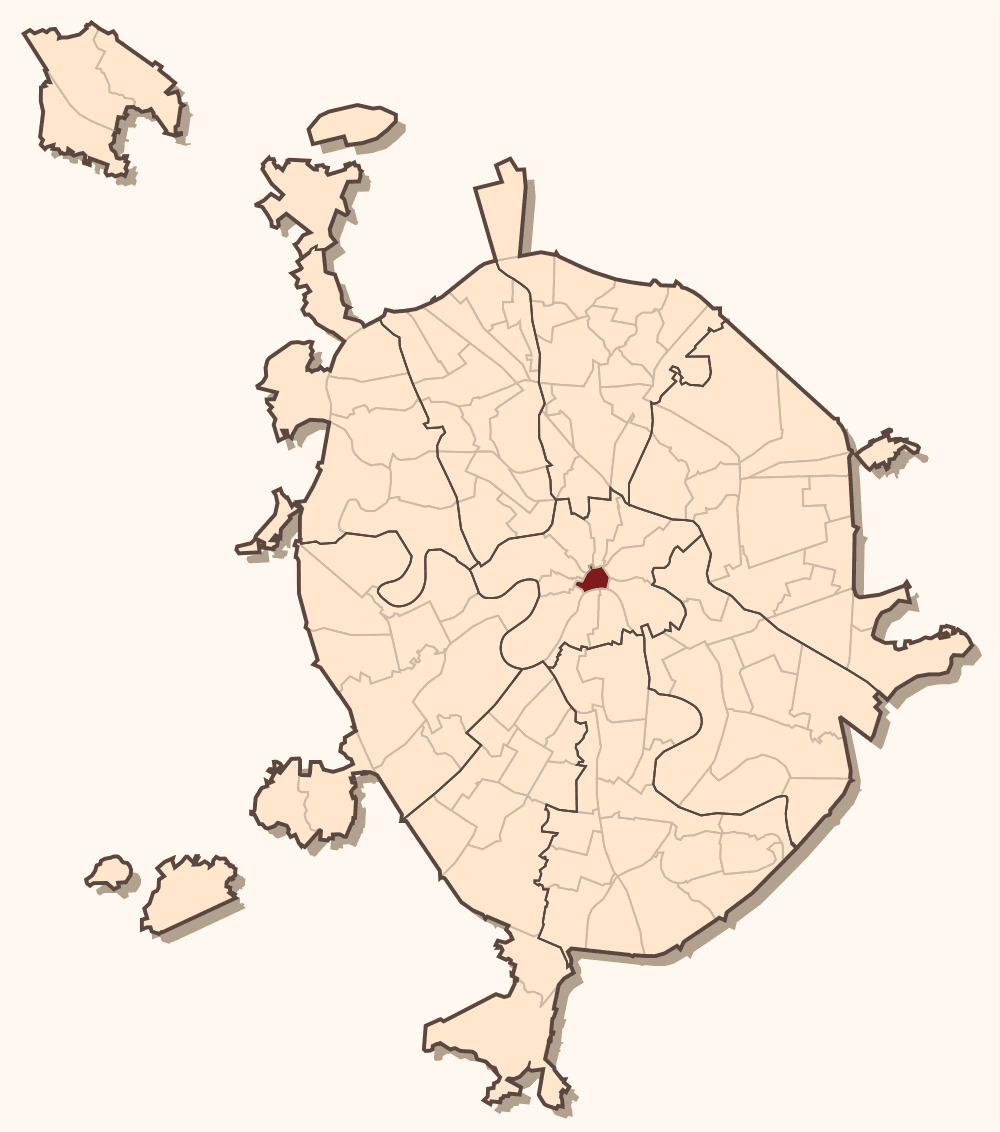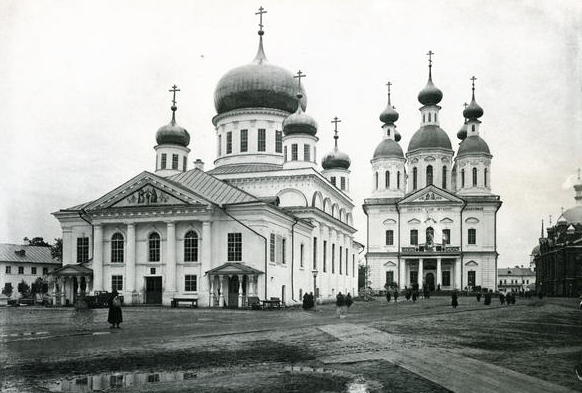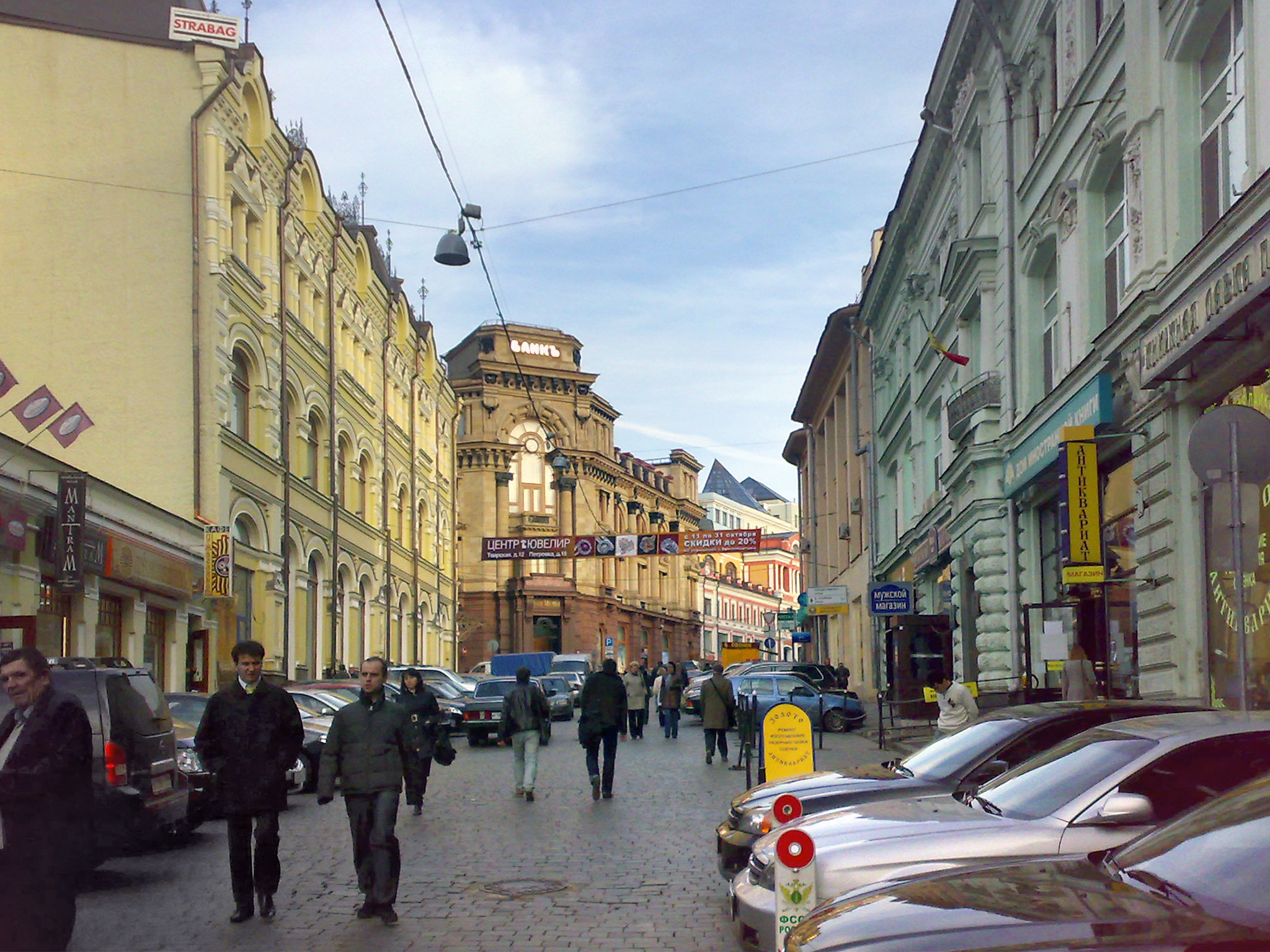|
Alexander Kaminsky
Alexander Stepanovich Kaminsky (1829–1897, russian: Александр Степанович Каминский, sometimes spelled Kamensky, Каменский) was a Russian architect working in Moscow and suburbs. One of the most successful and prolific architects of the 1860s–1880s, Kaminsky was a faithful eclecticist, equally skilled in Russian Revival, Neo-Gothic and Renaissance Revival architecture. He is best remembered for the extant Tretyakovsky Proyezd shopping arcade and the cathedral of Nikolo-Ugresh monastery in present-day town of Dzerzhinsky. Biography Kaminsky was born in a noble family in Kiev Governorate. In 1848–1857 he studied architecture under Konstantin Thon at the Imperial Academy of Arts in Saint Petersburg; meanwhile Alexander's brother, Joseph Kaminsky, was a construction manager for Thon's Cathedral of Christ the Saviour in Moscow. Alexander served as a liaison between Petersburg-based Thon and Moscow crews, acquiring his first practical experienc ... [...More Info...] [...Related Items...] OR: [Wikipedia] [Google] [Baidu] |
Vasily Khudyakov
Vasily Grigorievich Khudyakov (Russian: Василий Григорьевич Худяков; 24 December 1825, Akshuat, Ulyanovsk Oblast - 26 July 1871, Saint Petersburg) was a Russian history, portrait and Genre art, genre painter. Biography He began his studies at the Stroganov Moscow State University of Arts and Industry, then spent almost two years at the Moscow School of Painting, Sculpture and Architecture (MSPSA). His mentor there was Professor , who invited him to be an assistant for decorative work that was being done in the entrance hall of Grand Kremlin Palace, Kremlin Palace.Brief biography @ the Tretyakov Gallery. Some of his paintings were shown at the Imperial Academy of Arts, where they received a silver medal. [...More Info...] [...Related Items...] OR: [Wikipedia] [Google] [Baidu] |
Pavel Tretyakov
Pavel Mikhaylovich Tretyakov (russian: Па́вел Миха́йлович Третьяко́в; 27 December 1832 – 16 December 1898) was a Russian businessman, patron of art, collector, and philanthropist who gave his name to the Tretyakov Gallery and Tretyakov Drive in Moscow. His brother Sergei Tretyakov was also a famous patron of art and a philanthropist. Childhood Together with other Moscow businessmen he acted as the founder of the Moscow merchant bank (becoming one of its heads), the Moscow commercial and industrial company, some other large firms. He amassed a considerable fortune (4.4 million rubles), consisting of real estate (5 houses in Moscow), securities, money and bills. Collecting art Tretyakov started to collect art in 1854 at the age of 22; his first purchase was 10 canvases by Old Dutch masters. He laid down for himself the aim of creating a Russian National Gallery. In his collection Tretyakov included the most valuable and remarkable products, first of ... [...More Info...] [...Related Items...] OR: [Wikipedia] [Google] [Baidu] |
Bolshaya Ordynka Street
Bolshaya Ordynka is a historical street in Central Administrative Okrug of Moscow, Russia Russia (, , ), or the Russian Federation, is a List of transcontinental countries, transcontinental country spanning Eastern Europe and North Asia, Northern Asia. It is the List of countries and dependencies by area, largest country in the .... External links Streets in Moscow Central Administrative Okrug {{Moscow-geo-stub ... [...More Info...] [...Related Items...] OR: [Wikipedia] [Google] [Baidu] |
Gogol Boulevard
Gogolevsky Boulevard (russian: Гоголевский бульвар) is a boulevard near the Arbat District, Moscow, Russia, named after the writer Nikolai Gogol. It was named Prechistensky Boulevard (russian: Пречи́стенский бульвар) until 1924, after the nearby street Prechistenka. The boulevard begins next to the Cathedral of Christ the Saviour, and is the beginning of the Boulevard Ring. The boulevard runs north-east and ends at the Arbat Square Arbatskaya Square or Arbat Square () is one of the oldest squares of Moscow, located on the junction of Gogolevsky Boulevard, Znamenka Street and Arbat Gates Square (in 1925–1993 – part of Arbatskaya Square). The square is home to the Arbats ..., from where it continues as Nikitsky Boulevard. Boulevards in Moscow Cultural heritage monuments of regional significance in Moscow {{Moscow-geo-stub ... [...More Info...] [...Related Items...] OR: [Wikipedia] [Google] [Baidu] |
Kitai-gorod
Kitay-gorod ( rus, Китай-город, p=kʲɪˈtaj ˈɡorət), also referred to as the Great Possad () in the 16th and 17th centuries, is a cultural and historical area within the central part of Moscow in Russia, defined by the remnants of now almost entirely razed fortifications, narrow streets and very densely built cityscape. It is separated from the Kremlin by Red Square. Kitay-gorod does not constitute a district (''raion''), as there are no resident voters, thus, municipal elections are not possible. Rather, the territory has been part of Tverskoy District, and the Central Administrative Okrug authorities have managed the area directly since 2003. Etymology Beside Kitay-gorod in Moscovia (region), Moscovia in ancient Russia, Kitay was also a name for a sea. A sea called Kitay exists in Odessa in Ukraine. Older sources said that people with darker skin than other ethnic groups of Russia sold goods and traded with other peoples in the area of the Kitay sea. ''Kita ... [...More Info...] [...Related Items...] OR: [Wikipedia] [Google] [Baidu] |
Sarov
Sarov (russian: Саро́в) is a closed town in Nizhny Novgorod Oblast, Russia. It was known as Gorkiy-130 (Горький-130) and Arzamas-16 (), after a (somewhat) nearby town of Arzamas,SarovLabsCreation of Nuclear Center Arzamas-16/ref> from 1946 to 1991. Until 1995, it was known as Kremlyov/Kremlev/Kremljov (). The town is closed as it is the Russian center for nuclear research. Population: 92,047 ( 2010 Census); 87,652 ( 2002 Census) History The history of the town can be divided into two different periods. In the earlier history of Russia it was known as one of the holy places of the Russian Orthodox Church, because of its monastery, that gave Russia one of its greatest saints, St. Seraphim. Since the 1940s, it has gradually become the center for research and production of Soviet and later Russian nuclear weapons. The history of human settlement in the area around Sarov goes back at least to the 12th–13th centuries, when a large Mordvin settlement was foun ... [...More Info...] [...Related Items...] OR: [Wikipedia] [Google] [Baidu] |
Kuznetsky Most
Kuznetsky Most ( rus, Кузне́цкий Мост, p=kʊˈzʲnʲet͡skʲɪj ˈmost) is a street in central Moscow, that runs from Bolshaya Dmitrovka Street to Lubyanka Street. The name, literally ''Blacksmith's Bridge'', refers to the 18th-century bridge over the (now underground) Neglinnaya River, and a nearby foundry and the settlement of its workers. Since the middle of the 18th century, Kuznetsky Most has been a fashionable shopping street. The street is administered by Tverskoy District (west) and Meshchansky District (east). History Early history Until the end of 15th century, Moscow was growing eastward, into Kitai-gorod. Prince Ivan III of Russia established his arsenal (Пушечный двор, Cannon Court) in the west, beyond the Neglinnaya river. Later, he also set up a settlement of former Pskov residents, abducted from their hometown after the wars of the 1480s. Population grew slowly until the 1737 fire which razed the area. The Bridge Soon after the fir ... [...More Info...] [...Related Items...] OR: [Wikipedia] [Google] [Baidu] |
Max Hoeppener
Max or MAX may refer to: Animals * Max (dog) (1983–2013), at one time purported to be the world's oldest living dog * Max (English Springer Spaniel), the first pet dog to win the PDSA Order of Merit (animal equivalent of OBE) * Max (gorilla) (1971–2004), a western lowland gorilla at the Johannesburg Zoo who was shot by a criminal in 1997 Brands and enterprises * Australian Max Beer * Max Hamburgers, a fast-food corporation * MAX Index, a Hungarian domestic government bond index * Max Fashion, an Indian clothing brand Computing * MAX (operating system), a Spanish-language Linux version * Max (software), a music programming language * Commodore MAX Machine * Multimedia Acceleration eXtensions, extensions for HP PA-RISC Films * ''Max'' (1994 film), a Canadian film by Charles Wilkinson * ''Max'' (2002 film), a film about Adolf Hitler * ''Max'' (2015 film), an American war drama film Games * '' Dancing Stage Max'', a 2005 game in the ''Dance Dance Revolution'' series * ''DD ... [...More Info...] [...Related Items...] OR: [Wikipedia] [Google] [Baidu] |
Ilya Bondarenko
Ilya Yevgrafovich Bondarenko (russian: Илья Евграфович Бондаренко; 1867–1947) was a Russian-Soviet architect, historian and preservationist, notable for developing a particular style of Old Believers architecture in 1905-1917, blending Northern Russian revival with Art Nouveau. Education and early works Bondarenko trained at Moscow School of Painting, Sculpture and Architecture from 1887 to 1891 (class of Alexander Kaminsky), completing education at the Zurich Polytechnikum in 1894 and Fyodor Schechtel firm (1895–1896). He travelled within Russia throughout the 1890s, studying traditional architecture of the North and Volga regions. He was associated with Savva Mamontov-sponsored group of artists and Abramtsevo Colony; these connections helped him secure his first major project - Russian Crafts pavilions at the Exposition Universelle (1900) in Paris, in partnership with Konstantin Korovin. Later, Bondarenko would rely on Abramtsevo ceramics in most ... [...More Info...] [...Related Items...] OR: [Wikipedia] [Google] [Baidu] |
Ivan Mashkov
Ivan Pavlovich Mashkov (russian: Ива́н Па́влович Машко́в, 13 January 1867 – 1945) was a Russian architect and preservationist, notable for surveying and restoration of Dormition Cathedral of Moscow Kremlin, Novodevichy Convent and other medieval buildings. His best known extant building is ''Sokol'' (Falcon) luxury Art Nouveau apartment building in Kuznetsky Most Street, Moscow. A prolific architect, Mashkov built mostly eclectic buildings with Russian Revival features. Biography Education and early career Ivan Mikhailovich Sokolov (Иван Михайлович Евдокимов), son of a village blacksmith, lost both his parents in early childhood. He was adopted by Pavel Karpovich Mashkov, a Lipetsk businessman, and his wife, Natalya Yefimovna (née Andreyeva), thus acquiring the name of Mashkov. Natalya's brother, Alexey Yefimovich Andreev, was a town architect in Lipetsk. In 1881, Ivan was admitted to Moscow School of Painting, Sculpture and A ... [...More Info...] [...Related Items...] OR: [Wikipedia] [Google] [Baidu] |
Fyodor Schechtel
Fyodor Osipovich Schechtel (russian: Фёдор О́сипович Ше́хтель; August 7, 1859 – July 7, 1926) was a Russian architect, graphic artist and stage designer, the most influential and prolific master of Russian Art Nouveau and late Russian Revival architecture. Baptised as Franz Albert Schechtel (also transliterated as Shekhtel), he created most of his work as Franz Schechtel (Франц Шехтель), changing his name to Fyodor with the outbreak of World War I. In two decades of independent practice he completed five theaters, five churches, 39 private residences, Yaroslavsky Rail Terminal and various other buildings, primarily in Moscow. Most of his legacy survives to date. Biography Early life Franz Schechtel (Russified as Fyodor Osipovich) was born to a family of ethnic German engineers in Saint Petersburg, the second of five children. His parents were Volga Germans of Saratov. His mother, born Daria Karlovna Zhegin, came from a family of Saratov mercha ... [...More Info...] [...Related Items...] OR: [Wikipedia] [Google] [Baidu] |
Moscow School Of Painting, Sculpture And Architecture
The Moscow School of Painting, Sculpture and Architecture (russian: Московское училище живописи, ваяния и зодчества, МУЖВЗ) also known by the acronym MUZHZV, was one of the largest educational institutions in Russia. The school was formed by the 1865 merger of a private art college, established in Moscow in 1832, and the Palace School of Architecture, established in 1749 by Dmitry Ukhtomsky. By the end of the 19th-century, it vied with the state-run St. Petersburg Academy of Arts for the title of the largest art school in the country. In the 20th century, art and architecture separated again, into the Surikov Art Institute in Moscow () and the Moscow Architectural Institute (); the latter occupies the historical School buildings in Rozhdestvenka Street. History The Palace School of Architecture goes back to the classes of Dmitry Ukhtomsky that operated in 1749–1764. Twenty years, the classes were reinstated by Matvey Kazakov, an ... [...More Info...] [...Related Items...] OR: [Wikipedia] [Google] [Baidu] |






